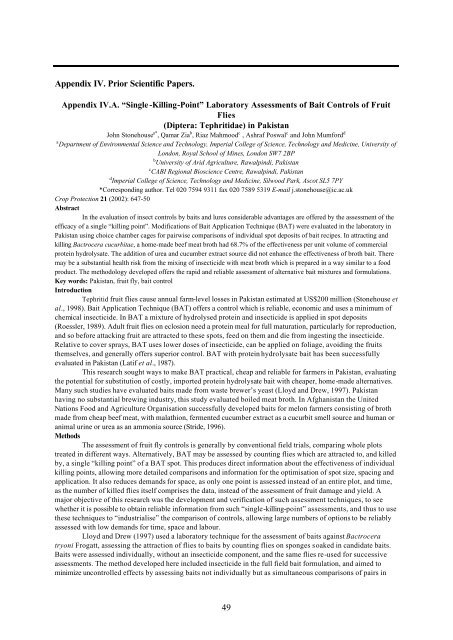“Key Informant Survey” of Production, Value, Losses and ... - DfID
“Key Informant Survey” of Production, Value, Losses and ... - DfID
“Key Informant Survey” of Production, Value, Losses and ... - DfID
You also want an ePaper? Increase the reach of your titles
YUMPU automatically turns print PDFs into web optimized ePapers that Google loves.
Appendix IV. Prior Scientific Papers.<br />
Appendix IV.A. “Single -Killing-Point” Laboratory Assessments <strong>of</strong> Bait Controls <strong>of</strong> Fruit<br />
Flies<br />
(Diptera: Tephritidae) in Pakistan<br />
John Stonehouse a* , Qamar Zia b , Riaz Mahmood c , Ashraf Poswal c <strong>and</strong> John Mumford d<br />
a<br />
Department <strong>of</strong> Environmental Science <strong>and</strong> Technology, Imperial College <strong>of</strong> Science, Technology <strong>and</strong> Medicine, University <strong>of</strong><br />
London, Royal School <strong>of</strong> Mines, London SW7 2BP<br />
b<br />
University <strong>of</strong> Arid Agriculture, Rawalpindi, Pakistan<br />
c<br />
CABI Regional Bioscience Centre, Rawalpindi, Pakistan<br />
d<br />
Imperial College <strong>of</strong> Science, Technology <strong>and</strong> Medicine, Silwood Park, Ascot SL5 7PY<br />
*Corresponding author. Tel 020 7594 9311 fax 020 7589 5319 E-mail j.stonehouse@ic.ac.uk<br />
Crop Protection 21 (2002): 647-50<br />
Abstract<br />
In the evaluation <strong>of</strong> insect controls by baits <strong>and</strong> lures considerable advantages are <strong>of</strong>fered by the assessment <strong>of</strong> the<br />
efficacy <strong>of</strong> a single “killing point”. Modifications <strong>of</strong> Bait Application Technique (BAT) were evaluated in the laboratory in<br />
Pakistan using choice chamber cages for pairwise comparisons <strong>of</strong> individual spot deposits <strong>of</strong> bait recipes. In attracting <strong>and</strong><br />
killing Bactrocera cucurbitae, a home-made beef meat broth had 68.7% <strong>of</strong> the effectiveness per unit volume <strong>of</strong> commercial<br />
protein hydrolysate. The addition <strong>of</strong> urea <strong>and</strong> cucumber extract source did not enhance the effectiveness <strong>of</strong> broth bait. There<br />
may be a substantial health risk from the mixing <strong>of</strong> insecticide with meat broth which is prepared in a way similar to a food<br />
product. The methodology developed <strong>of</strong>fers the rapid <strong>and</strong> reliable assessment <strong>of</strong> alternative bait mixtures <strong>and</strong> formulations.<br />
Key words: Pakistan, fruit fly, bait control<br />
Introduction<br />
Tephritid fruit flies cause annual farm-level losses in Pakistan estimated at US$200 million (Stonehouse et<br />
al., 1998). Bait Application Technique (BAT) <strong>of</strong>fers a control which is reliable, economic <strong>and</strong> uses a minimum <strong>of</strong><br />
chemical insecticide. In BAT a mixture <strong>of</strong> hydrolysed protein <strong>and</strong> insecticide is applied in spot deposits<br />
(Roessler, 1989). Adult fruit flies on eclosion need a protein meal for full maturation, particularly for reproduction,<br />
<strong>and</strong> so before attacking fruit are attracted to these spots, feed on them <strong>and</strong> die from ingesting the insecticide.<br />
Relative to cover sprays, BAT uses lower doses <strong>of</strong> insecticide, can be applied on foliage, avoiding the fruits<br />
themselves, <strong>and</strong> generally <strong>of</strong>fers superior control. BAT with protein hydrolysate bait has been successfully<br />
evaluated in Pakistan (Latif et al., 1987).<br />
This research sought ways to make BAT practical, cheap <strong>and</strong> reliable for farmers in Pakistan, evaluating<br />
the potential for substitution <strong>of</strong> costly, imported protein hydrolysate bait with cheaper, home-made alternatives.<br />
Many such studies have evaluated baits made from waste brewer’s yeast (Lloyd <strong>and</strong> Drew, 1997). Pakistan<br />
having no substantial brewing industry, this study evaluated boiled meat broth. In Afghanistan the United<br />
Nations Food <strong>and</strong> Agriculture Organisation successfully developed baits for melon farmers consisting <strong>of</strong> broth<br />
made from cheap beef meat, with malathion, fermented cucumber extract as a cucurbit smell source <strong>and</strong> human or<br />
animal urine or urea as an ammonia source (Stride, 1996).<br />
Methods<br />
The assessment <strong>of</strong> fruit fly controls is generally by conventional field trials, comparing whole plots<br />
treated in different ways. Alternatively, BAT may be assessed by counting flies which are attracted to, <strong>and</strong> killed<br />
by, a single “killing point” <strong>of</strong> a BAT spot. This produces direct information about the effectiveness <strong>of</strong> individual<br />
killing points, allowing more detailed comparisons <strong>and</strong> information for the optimisation <strong>of</strong> spot size, spacing <strong>and</strong><br />
application. It also reduces dem<strong>and</strong>s for space, as only one point is assessed instead <strong>of</strong> an entire plot, <strong>and</strong> time,<br />
as the number <strong>of</strong> killed flies itself comprises the data, instead <strong>of</strong> the assessment <strong>of</strong> fruit damage <strong>and</strong> yield. A<br />
major objective <strong>of</strong> this research was the development <strong>and</strong> verification <strong>of</strong> such assessment techniques, to see<br />
whether it is possible to obtain reliable information from such “single-killing-point” assessments, <strong>and</strong> thus to use<br />
these techniques to “industrialise” the comparison <strong>of</strong> controls, allowing large numbers <strong>of</strong> options to be reliably<br />
assessed with low dem<strong>and</strong>s for time, space <strong>and</strong> labour.<br />
Lloyd <strong>and</strong> Drew (1997) used a laboratory technique for the assessment <strong>of</strong> baits against Bactrocera<br />
tryoni Frogatt, assessing the attraction <strong>of</strong> flies to baits by counting flies on sponges soaked in c<strong>and</strong>idate baits.<br />
Baits were assessed individually, without an insecticide component, <strong>and</strong> the same flies re-used for successive<br />
assessments. The method developed here included insecticide in the full field bait formulation, <strong>and</strong> aimed to<br />
minimize uncontrolled effects by assessing baits not individually but as simultaneous comparisons <strong>of</strong> pairs in<br />
49

















